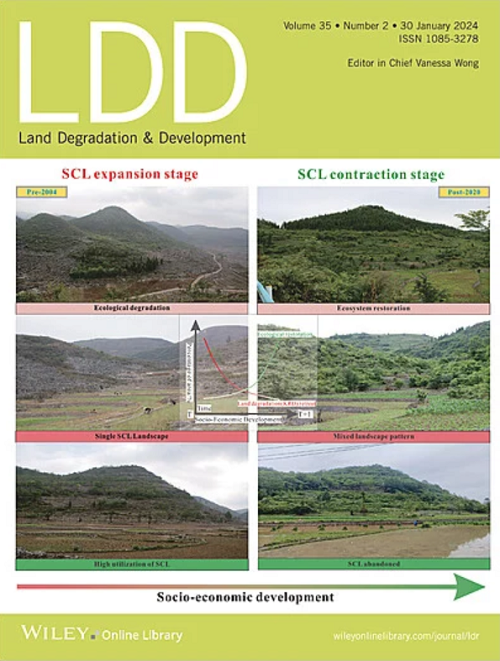整合GIS和多标准分析的可持续畜牧业:埃塞俄比亚半干旱达瓦流域生物物理和社会经济决定因素的整体评估
IF 3.6
2区 农林科学
Q2 ENVIRONMENTAL SCIENCES
引用次数: 0
摘要
半干旱地区牧地退化威胁着牧民生计和生态系统服务,因此必须在可持续土地管理计划中找到综合方法的一席之地。在这方面,该研究利用基于GIS的多标准评估来确定半干旱达瓦流域的牲畜放牧适宜性和退化风险,将五个相关生物物理参数(土地利用/覆盖、降雨、水分可及性、坡度和土壤类型)与专家信息调查得出的社会经济指标结合起来。重要的是,土地利用/覆被分类的准确率达到98.3% (kappa = 0.97),证实了该方法的合理性。在被评估的物种中,发现骆驼有相当比例的合适牧场,72%中等合适,20%高度合适,从而强调了针对该物种的特定管理方法的潜力。此外,结合三个社会经济变量,包括服务可达性(β = 0.65)、基础设施质量(β = 0.61)和市场可达性(β = 0.40),多元回归分析表明,这些变量可以解释78.9%的牧场适宜性方差。在某种程度上,这些结果强调了同时处理环境和社会经济事务的重要必要性,以阻止土地退化,改善生态系统生产,并从长远来看维持牧民生计。因此,该研究建议加强基础设施和市场一体化,并将具体分区作为半干旱牧地可持续土地管理实践的先决条件。本文章由计算机程序翻译,如有差异,请以英文原文为准。
Integrating GIS and Multi‐Criteria Analysis for Sustainable Livestock Grazing: A Holistic Assessment of Biophysical and Socio‐Economic Determinants in Semi‐Arid Dawa Watershed of Ethiopia
The degradation of rangelands in semi‐arid areas threatens pastoral livelihoods and ecosystem services, making it imperative that integrated approaches find a place in the sustainable land management program. In this regard, the study made use of GIS‐based multi‐criteria evaluation to determine livestock grazing suitability and degradation risks in the semi‐arid Dawa watershed, integrating five relevant biophysical parameters (land use/cover, rainfall, water accessibility, slope, and soil type) with socio‐economic indicators derived from expert informant surveys. Importantly, land use/cover classification recorded an accuracy of 98.3% (kappa = 0.97), confirming the soundness of the methodology. Among the species assessed, camels were found to have a fair share of appropriate rangelands, 72% moderately suitable, and 20% highly suitable, thus emphasizing the potential for specific management approaches targeting this species. Furthermore, with the three assembled socio‐economic variables including service accessibility (β = 0.65), infrastructure quality (β = 0.61), and market accessibility (β = 0.40), multiple regression analysis showed these were useful in explaining 78.9% of variance in rangeland suitability. In a way, these results stress the important need to run environmental and socio‐economic affairs in parallel to halt land degradation, improve ecosystem production, and sustain pastoral livelihoods in the long run. Thus, the study recommends an enhancement of infrastructure and market integration, coupled with specific zoning as the prerequisite sustainable land management practices in semi‐arid rangeland situations.
求助全文
通过发布文献求助,成功后即可免费获取论文全文。
去求助
来源期刊

Land Degradation & Development
农林科学-环境科学
CiteScore
7.70
自引率
8.50%
发文量
379
审稿时长
5.5 months
期刊介绍:
Land Degradation & Development is an international journal which seeks to promote rational study of the recognition, monitoring, control and rehabilitation of degradation in terrestrial environments. The journal focuses on:
- what land degradation is;
- what causes land degradation;
- the impacts of land degradation
- the scale of land degradation;
- the history, current status or future trends of land degradation;
- avoidance, mitigation and control of land degradation;
- remedial actions to rehabilitate or restore degraded land;
- sustainable land management.
 求助内容:
求助内容: 应助结果提醒方式:
应助结果提醒方式:


